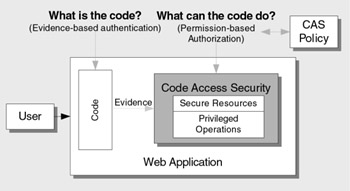User vs. Code Security
User vs. Code Security
User security and code security are two complementary forms of security that are available to .NET Framework applications. User security answers the questions, "Who is the user and what can the user do?" while code security answers the questions "Where is the code from, who wrote the code, and what can the code do?" Code security involves authorizing the application's (not the user's) access to system-level resources, including the file system, registry, network, directory services, and databases. In this case, it does not matter who the end user is, or which user account runs the code, but it does matter what the code is and is not allowed to do.
The .NET Framework user security implementation is called role-based security . The code security implementation is called code access security .
Role-Based Security
.NET Framework role-based security allows a Web application to make security decisions based on the identity or role membership of the user that interacts with the application. If your application uses Windows authentication, then a role is a Windows group . If your application uses other forms of authentication, then a role is application-defined and user and role details are usually maintained in SQL Server or user stores based on Active Directory.
The identity of the authenticated user and its associated role membership is made available to Web applications through Principal objects, which are attached to the current Web request.
Figure 6.1 shows a logical view of how user security is typically used in a Web application to restrict user access to Web pages, business logic, operations, and data access.

Figure 6.1: A logical view of (user) role-based security
Code Access Security
Code access security authorizes code when it attempts to access secured resources, such as the file system, registry, network, and so on, or when it attempts to perform other privileged operations, such as calling unmanaged code or using reflection.
Code access security is an important additional defense mechanism that you can use to provide constraints on a piece of code. An administrator can configure code access security policy to restrict the resource types that code can access and the other privileged operations it can perform. From a Web application standpoint, this means that in the event of a compromised process where an attacker takes control of a Web application process or injects code to run inside the process, the additional constraints that code access security provides can limit the damage that can be done.
Figure 6.2 shows a logical view of how code access security is used in a Web application to constrain the application's access to system resources, resources owned by other applications, and privileged operations, such as calling unmanaged code.

Figure 6.2: Logical view of code-based security
The authentication (identification) of code is based on evidence about the code, for example, its strong name , publisher, or installation directory. Authorization is based on the code access permissions granted to code by security policy. For more information about .NET Framework code access security, see Chapter 8, "Code Access Security in Practice."
EAN: 2147483647
Pages: 613